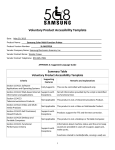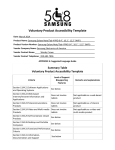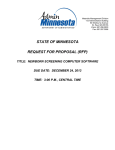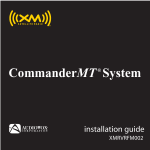Download Avaya 2500 Series Analog Telephones Voluntary Product
Transcript
Avaya 2500 Series Analog Telephones Voluntary Product Accessibility Template (VPAT) The Avaya 2500 Series Analog Telephones that are presently being produced are the Models 2500 MMGN, 2500 YMGP, 2554 MMGN, and 2554 YMGP. The 2500 telephones are desktop sets. The 2554 telephones are wall-mounted. The MMGN versions are basic telephones. Features that are included in the YMGP versions, that are not included in the MMGN versions, include a mute button, a flash button, a redial button, a hold button, a message-waiting LED, and a hold LED. § 1194.23 Telecommunications Products Criteria Supporting Features Remarks and Explanations 1194.23(a) Telecommunications products or systems which provide a function allowing voice communication and which do not themselves provide a TTY functionality shall provide a standard non-acoustic connection point for TTYs. Microphones shall be capable of being turned on and off to allow the user to intermix speech with TTY use. Avaya 2500 Series Analog Telephones conform to this requirement. (Please refer to Remarks for configuration guidance.) Most TTYs that permit an electronic, nonacoustic connection to the telephone network do so through RJ-11 tip/ring connectors of the sort found on residential analog telephone equipment. This is the same connector used by Avaya 2500 Series Analog Telephones. A standard non-acoustic connection point for TTYs is provided by connecting the TTY and the telephone to the same phone line. The ability to turn microphones on and off is satisfied by the “mute” and “hold” buttons on the YMGP telephones. (Both buttons will turn the microphone off. The difference is that the “mute” button must be pressed continuously in order to disable the microphone. By contrast, “hold” is toggled function, i.e., it is activated by pressing and releasing the button, and remains active until a second Avaya 2500 Series Analog Telephones Page 1 of 5 press-and-release.) The MMGN telephones do not have a mute or hold function. These phones permit the microphone to be turned on and off when configured in the following manner: 1194.23(b) Telecommunications products, which include voice communication functionality, shall support all commonly used crossmanufacturer non-proprietary standard TTY signal protocols. 1194.23(c) Voice mail, autoattendant, and interactive voice response telecommunications systems shall be usable by TTY users with their TTYs. 1194.23(d) Voice mail, messaging, auto-attendant, and interactive voice response telecommunications systems that require a response from a user within a time interval, shall give an alert when the time interval is about to run out, and shall provide sufficient time for the user to indicate more time is required. 1194.23(e) Where provided, caller identification and similar telecommunications functions shall also be available for users of TTYs, and for users who cannot see displays. Avaya 2500 Series Analog Telephones conform to this requirement. This requirement applies to voice mail, auto-attendant, and interactive voice response systems. It does not apply to Avaya 2500 Series Analog Telephones. This requirement applies to voice mail, auto-attendant, and interactive voice response systems. It does not apply to Avaya 2500 Series Analog Telephones. This requirement does not apply to Avaya 2500 Series Analog Telephones because these telephones do not have a built-in caller ID capability. Nevertheless, for users who require caller ID information, these telephones may be Avaya 2500 Series Analog Telephones The TTY device must be bridged to the telephone and “off-hook” continuously during the call. The user may turn the telephone’s microphone off by placing the handset in the cradle. (The call is not dropped because the TTY is bridged onto the line and is still active.) Lifting the handset out of the cradle will turn the microphone back on. When Avaya 2500 Series Analog Telephones are configured in the manner described in the Remarks for 1194.23(a), all of the cross-manufacturer nonproprietary TTY signal protocols that are commonly used in the US are supported. There is no aspect of Avaya 2500 Series Analog Telephones that would interfere with the operation or compliance of voice mail, auto-attendant, or interactive voice response systems. There is no aspect of Avaya 2500 Series Analog Telephones that would interfere with the operation or compliance of voice mail, auto-attendant, or interactive voice response systems. Standard residential-grade caller ID adjuncts may be used in conjunction with Avaya 2500 Series Analog Telephones. (Although most of these adjuncts provide LCD displays, voice-output adjuncts are available for people with visual impairments.) These adjuncts are connected to the telephones in exactly Page 2 of 5 used in conjunction with readily available caller ID adjuncts. (Refer to the Remarks section for more information.) 1194.23(f) For transmitted voice signals, telecommunications products shall provide a gain adjustable up to a minimum of 20 dB. For incremental volume control, at least one intermediate step of 12 dB of gain shall be provided. 1194.23(g) If the telecommunications product allows a user to adjust the receive volume, a function shall be provided to automatically reset the volume to the default level after every use. 1194.23(h) Where a telecommunications product delivers output by an audio transducer which is normally held up to the ear, a means for effective magnetic wireless coupling to hearing technologies shall be provided. 1194.23(i) Interference to hearing technologies (including hearing aids, cochlear implants, and assistive listening devices) shall be reduced to the lowest possible level that allows a user of hearing technologies to utilize the telecommunications product. 1194.23(j) Products that transmit or conduct information or communication, shall pass through cross-manufacturer, non-proprietary, industry-standard codes, translation Avaya 2500 Series Analog Telephones conform to this requirement when used in conjunction with an Avaya variable amplitude handset. Avaya 2500 Series Analog Telephones conform to this requirement when used in conjunction with an Avaya variable amplitude push-tolisten handset. Avaya 2500 Series Analog Telephones conform to this requirement. the same way that they are used with residential telephone equipment. The use of a caller ID adjunct will not interfere with the telephone's ability to satisfy other accessibility requirements, such TTY compatibility. Avaya variable amplified handsets are available in a variety of shapes and colors. The models also differ in their electrical characteristics. When purchasing one of these handsets, it is important to select one that will be compatible with the associated telephone. Avaya 2500 Series Analog Telephones use Avaya K-type handsets. For users and environments that also require compliance with 1194.23(g), Avaya Model K8S2-003 and K8S2-215 handsets are recommended. Avaya 2500 Series Analog Telephones use Avaya K-type handsets. Requirements 1194.23(f) and 1194.23(g) are satisfied when the telephone is equipped with an Avaya Model K8S2-003 or K8S2-215 handset. All Avaya handsets have primary electromagnetic inductive coils, permitting the phones to be used with inductively coupled assistive hearing devices such as telecoil-equipped hearing aids and cochlear implants. Avaya 2500 Series Analog Telephones conform to this requirement. Avaya 2500 Series Analog Telephones conform to FCC standards for electromagnetic shielding. Avaya 2500 Series Analog Telephones conform to this requirement. When Avaya 2500 Series Analog Telephones are configured in the manner described in the Remarks for 1194.23(a), all of the cross-manufacturer nonproprietary TTY signal protocols that are Avaya 2500 Series Analog Telephones Page 3 of 5 protocols, formats or other information necessary to provide the information or communication in a usable format. Technologies which use encoding, signal compression, format transformation, or similar techniques shall not remove information needed for access or shall restore it upon delivery. 1194.23(k)(1) Products which have mechanically operated controls or keys shall comply with the following: Controls and Keys shall be tactilely discernible without activating the controls or keys. 1194.23(k)(2) Products which have mechanically operated controls or keys shall comply with the following: Controls and Keys shall be operable with one hand and shall not require tight grasping, pinching, twisting of the wrist. The force required to activate controls and keys shall be 5 lbs. (22.2N) maximum. 1194.23(k)(3) Products which have mechanically operated controls or keys shall comply with the following: If key repeat is supported, the delay before repeat shall be adjustable to at least 2 seconds. Key repeat rate shall be adjustable to 2 seconds per character. 1194.23(k)(4) Products which have mechanically operated controls or keys shall comply with the following: The status of all locking or toggle controls or keys shall be visually discernible, and discernible either through touch or sound. commonly used in the US are supported. Avaya 2500 Series Analog Telephones conform to this requirement. The dial pads on Avaya 2500 Series Analog Telephones are arranged in a standard manner, with a raised bar on the 5-key, thereby making “tactile navigation” easier for people with visual impairments. Avaya 2500 Series Analog Telephones conform to this requirement. Avaya 2500 Series Analog Telephones conform to this requirement. There are no key repeat functions in Avaya 2500 Series Analog Telephones. This requirement does not apply to Avaya 2500 Series MMGN Analog Telephones because these phones have no locking keys or toggle controls. On Avaya 2500 Series YMGP Analog Telephones, a red LED illuminates when the phone is on hold. In addition, the “on hold” condition is discernible audibly by listening for the presence or absence of circuit noise and/or audio transmissions from the other party. Avaya 2500 Series YMGP Analog Telephones conform to this requirement. (Please refer to Remarks for configuration guidance.) Avaya 2500 Series Analog Telephones On Avaya 2500 Series YMGP Analog Telephones, a red LED illuminates when the associated voicemail mailbox contains one or more new messages. This condition is discernible audibly by enabling the “stutter dial tone” function Page 4 of 5 on the Avaya Communication Manager system. In addition to providing an audible ring signal to alert users that there is an incoming call, the message-waiting LED on Avaya 2500 Series YMGP Analog Telephones “flutters” in synchronization with the ringing, thereby providing a visual indication that there is an incoming call. © 2009 Avaya Inc. All rights reserved. Except as specifically stated, none of the material may be copied, reproduced, distributed, republished, downloaded, displayed, posted, or transmitted in any form without authorized, prior written permission from Avaya Inc. Permission is granted for you to make a single copy of Avaya Inc. “Section 508” documents, solely for informational and non-commercial use within your organization, provided that you keep intact all copyright and other proprietary notices. No other use of the information provided is authorized. This market information is provided, pursuant to FAR Part 39.2, to be used by Requiring Officers. It is not intended to represent a certification for compliance. Any statement of compliance or conformance indicated on this document is an indication that the product shall be capable, at the time of its delivery, when used in accordance with Avaya's associated documents, and other written information provided to the government, of providing comparable access to individuals with disabilities consistent with the designated provision of the Standards, provided that any assistive technologies used with the product properly interoperates with it and other assistive technologies. Updated 10 June 2008 Avaya 2500 Series Analog Telephones Page 5 of 5















